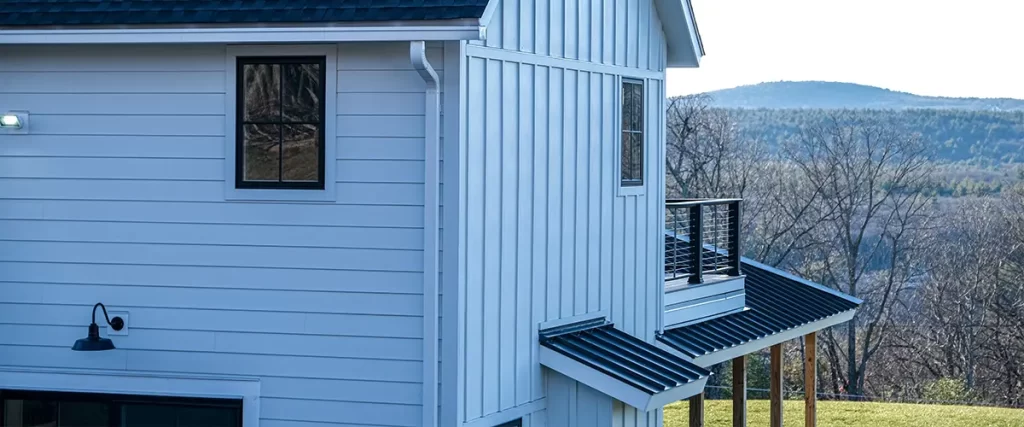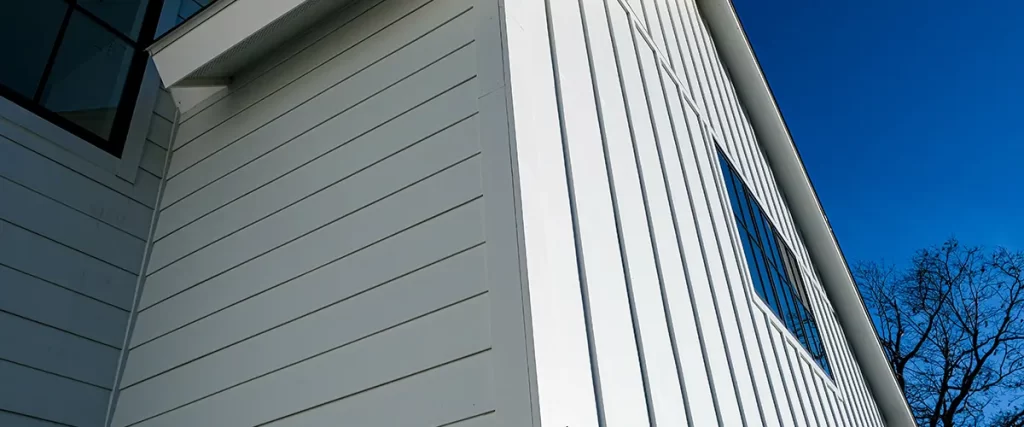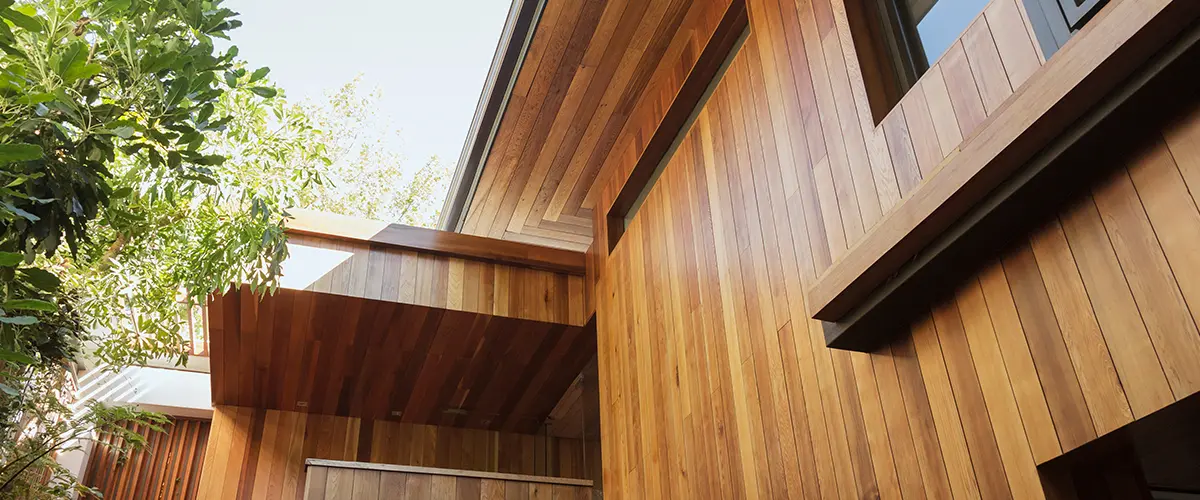Did you know that engineered wood siding offers many advantages over traditional alternatives? This comprehensive guide will unpack everything you need to know about this cost-effective, durable product – from its numerous benefits and installation process to maintenance tips.
Ready to upgrade your exterior with engineered wood siding? Let’s dive in!

Key Takeaways
- Engineered wood siding is a durable, cost-effective option for home exteriors.
- It's made by combining wood with resin and wax, making it stronger than natural wood.
- Engineered wood siding can withstand harsh weather and resist damage from insects.
- This type of siding requires less maintenance than natural wood and only needs to be painted every 5 - 10 years.
- Installing engineered wood is easy because the material is lightweight and doesn't require special tools.
- Cleaning engineered wooden panels regularly will help maintain their durability and appearance over time.
What Is Engineered Wood Siding?
Engineered wood siding is a highly durable material that offers the aesthetic appeal of natural wood without its associated downsides. It’s constructed by combining wood materials with resin and wax, creating a strong bond to withstand temperature fluctuations.
Despite being cheaper than real wood siding, engineered wood does not compromise on quality or durability. Its cost-effectiveness, coupled with availability in various colors, makes it an increasingly popular choice among homeowners for their new siding projects.
Comparison To Natural Wood Siding
Engineered wood siding and natural wood siding each have unique characteristics that make them ideal for different scenarios. To help you make an informed decision about which is right for you, here is a comparison between the two.
| Factors | Engineered Wood Siding | Natural Wood Siding |
|---|---|---|
| Durability | Engineered wood siding is engineered to withstand harsh weather conditions and resist damage from insects and moisture. | Natural wood siding, while durable, is more susceptible to damage from insects and moisture. |
| Maintenance | Engineered wood siding requires less maintenance than natural wood siding. It typically only needs to be painted every 5-10 years. | Natural wood siding requires regular maintenance, including painting or staining every 2-3 years to prevent weathering and decay. |
| Cost | Engineered wood siding is generally more cost-effective, both in terms of initial cost and long-term maintenance costs. | Natural wood siding, while beautiful, can be costly both to install and maintain. |
| Environmental Impact | Engineered wood siding is made from recycled wood materials, making it a more environmentally friendly option. | Natural wood siding requires the cutting of trees, which has a greater environmental impact. |
| Installation | Engineered wood siding is lighter and easier to install than natural wood siding. | Natural wood siding can be more challenging and time-consuming to install due to its weight and complexity. |
Pros And Cons Of Engineered Wood Siding
| Pros of Engineered Wood Siding | Cons of Engineered Wood Siding |
|---|---|
| High Durability: Engineered wood siding is extremely durable, withstanding harsh weather conditions and resisting damage from insects and rot. | Higher Cost than Vinyl: Although less expensive than natural wood, engineered wood siding can cost more than vinyl siding. |
| Cost-Effective: It provides the look and feel of real wood at a fraction of the cost, making it a cost-effective choice for homeowners. | Professional Installation Needed: The installation of engineered wood siding usually requires a professional, which can add to the overall expense. |
| Design Versatility: Available in a wide range of styles, colors, and finishes, engineered wood siding gives homeowners a wealth of design options. | Requires Maintenance: Though it requires less maintenance than natural wood, engineered wood siding still needs periodic painting or staining to keep its appearance. |
| Environmentally Friendly: Since it's made from recycled materials and sustainable wood sources, engineered wood siding is a more eco-friendly choice. | Not as Natural: Despite its resemblance to real wood, engineered wood siding may not provide the same natural warmth and aesthetic as 100% wood siding. |
Cost Considerations
Engineered wood siding costs can vary based on several factors. Different brands and qualities of engineered wood will come at distinct price points. Overall, it’s a more cost-effective alternative to traditional wood siding.
Savings extend beyond just initial material costs; due to its durability, the need for repairs is less likely, which also equates to lower maintenance expenses over time.
The installation process of engineered wood siding is relatively straightforward and requires fewer special tools than other materials like vinyl or fiber cement. Renting or buying these tools isn’t necessary, creating additional savings for homeowners opting for engineered wooden panels.
However, labor costs may factor in if professional installers are hired instead of adopting a do-it-yourself approach.
Available Colors And Brands
Engineered wood siding offers a broad spectrum of colors for homeowners, from warm reds and cool blues to natural greens and neutral tones. Each brand presents its own unique palette so you can find the perfect fit for your residence’s exterior design.
Top manufacturers like LP SmartSide have revolutionized the industry with their innovative engineered siding products, known for supreme durability and stunning finishes. KWP Eco-Side also provides an impressive selection of colors crafted with eco-friendly materials.
Another popular choice among homeowners is James Hardie Fiber Cement Siding due to its high-quality construction and diverse color options that resist fading over time. Explore these brands and more to select the best-engineered wood siding suited to your style preference.

Benefits of Engineered Wood Siding
Explore the impressive benefits of engineered wood siding, including its superior durability, cost-effectiveness, ease of installation, rich design options, and low maintenance requirements.
Delve into the details to make an informed choice for your home. Read on and discover more!
Durability
Engineered wood siding stands up to extreme weather conditions without rotting or warping. Manufactured with zinc borate, it demonstrates resistance against termites and fungal decay.
This advanced material also withstands temperature fluctuations, ensuring the longevity of your home’s exterior in all seasons.
Unlike traditional wood siding, this modern alternative does not require constant repainting or staining to maintain its durable nature. It handles moisture well, reducing risks of water damage that can lead to costly repairs.
Therefore, engineered wood siding offers homeowners a sturdy yet stylish option for their homes’ exteriors that lasts longer with lesser maintenance.
Cost-Effectiveness
Engineered wood siding emerges as a cost-effective solution for many homeowners. The initial investment is relatively lower compared to other materials like cedar or fiber cement.
While natural wood demands frequent maintenance, engineered wood reduces costs in the long run with its high durability and low upkeep needs.
Easy installation further brings down labor costs, making this material an economically sound option for your home’s exterior renovation project. It gives you uncompromised quality without breaking your bank account, thus highlighting its impressive value proposition in the market of siding materials.
Easy installation
Engineered wood siding offers an easy installation process that most homeowners find convenient. The lightweight nature of the material reduces labor costs and shortens project timelines significantly.
Unlike traditional wood, engineered wood siding comes in bigger panels with fewer seams, simplifying the task for installers. No special tools are required since regular carpentry implements can manage the cut and fit perfectly.
This ease of installation allows homeowners to create or switch to a durable, pleasing exterior without having to waste time or resources unnecessarily. Even better? You won’t have to deal with harmful dust often associated with fiber cement siding installations or spending extra on asbestos safety equipment.
With engineered wood siding, you will experience reduced labor costs and enjoy faster project completion times while ensuring your home withstands temperature fluctuations well into the future and meets various design aesthetics.
Design Options
Engineered wood siding offers a wide variety of design choices to homeowners. It can be smoothly painted or stained in any color, providing the flexibility to match your home’s current aesthetic or create a whole new look.
Not only does this siding come in various styles like traditional lap, panel, and vertical siding, but it also includes detailed trim options for additional styling possibilities. You can even have your engineered wood panels cut into unique shapes and sizes to further enhance your house’s exterior design.
Many manufacturers produce engineered wood products that mimic other popular materials, such as cedar siding, creating an authentic look while offering increased durability and easy maintenance.
By choosing engineered wood siding for your new siding project, you’re investing in flexible design possibilities alongside outstanding performance features.
Low Maintenance
Engineered wood siding steals the show with its low maintenance requirements. This attractive feature makes it a favorite among busy homeowners. Unlike traditional wood, there’s no need to stress over frequent painting or staining jobs.
Engineered wood siding holds paint well and can stay looking fresh for years.
Also, you won’t have to worry about moisture issues that often plague traditional wood sidings. The manufacturing process of engineered wood gives it excellent resistance against rot and mold attacks.
There is also no concern about termite infestations as these pests find engineered wood unappetizing! So put your feet up and enjoy peace of mind with this nearly self-sufficient material on your house exterior.

Installation and Maintenance of Engineered Wood Siding
Discover practical techniques for installing engineered wood siding and maintaining it for long-lasting appeal and efficiency. Delve into this comprehensive guide to learn more about the proper hiring of professional contractors, useful installation tips, and guidelines for cleaning and maintenance that will ensure durability and protection of your home’s exterior.
Learn how cost-effective engineered wood siding can transform your home while providing dependable protection against various elements; read on to find out more!
Hiring A Professional Contractor
Hiring a professional contractor becomes crucial for the successful installation of engineered wood siding. Expert contractors know how to handle and install this material properly, ensuring maximum durability and aesthetic appeal.
They come equipped with special tools required for cutting and fitting the panels without causing any damage or unnecessary waste. Besides, their wealth of experience aids in foreseeing potential issues like water damage or termite infestations that might affect your siding in the future.
So, investing in a knowledgeable contractor not only safeguards your home’s exterior but also enhances its overall value.
Tips For Proper Installation
Proper installation of engineered wood siding will not only enhance the curb appeal of your house but also increase its overall value. Here are some tips to ensure successful installation:
- Always consult with a professional contractor.
- Ensure all necessary materials are at hand before starting.
- Follow the manufacturer’s guidelines for installation.
- Use the right tools for cutting and nailing the siding panels.
- Keep a consistent gap between boards during installation.
- Adequate overlap is key in preventing water damage.
- Always check for and maintain levelness throughout the installation.
- Trim any excess material from ends and corners for a smooth finish.
- Perform regular checks during installation to ensure alignment and adherence to the design plan.
- Prioritize safety during the process – wear protective gear, especially eye protection and work gloves.
Cleaning And Maintenance Guidelines
Engineered wood siding offers convenience and longevity, but it still requires some care to maintain its aesthetic appeal. Here are some helpful guidelines for cleaning and maintenance:
- Use a soft brush or pressure washer with caution to clean dirt or debris off your siding.
- Apply a bleach-free cleaner to remove any mildew or mold spots.
- Avoid direct heat or fire exposure to prevent potential damage.
- Inspect the siding annually for any signs of damage, like cracks, chips, or peeling paint.
- Repaint your engineered wood siding every 5 – 7 years to keep it looking fresh and vibrant.
- Keep plants and shrubbery trimmed back from the siding to prevent moisture build-up and potential rot.
- Ensure gutters are kept clear to avoid water run-off damaging your siding.
Long-Term Durability And Protection
Engineered wood siding is designed to stand the test of time, offering robust protection for years. Its makeup includes elements that help resist termites, fungal decay, and even harsh weather conditions.
Premium engineered wood siding products are treated with zinc borate, a substance known to deter pests and boost longevity. With proper maintenance, such as regular cleaning and paint touch-ups when required, your home’s exterior will keep its luster while staying structurally sound.
This siding not only enhances your home’s aesthetic appeal but also safeguards it from potential external damage over an extended period of time.

Engineered Wood Siding FAQs
Engineered wood siding is a type of home exterior covering. It is made from wood products such as sawdust, combined with bonding agents for strength.
This siding emulates the look of traditional wood but provides greater durability. Engineered wood is resistant to elements like moisture, pests, and rot.
Selecting engineered wood siding is an investment in long-lasting appeal, low maintenance, and robust protection for your home.
Engineered wood siding typically lasts between 20 to 30 years, but with proper maintenance, it can last even longer. The longevity of this siding is due to its resistance to elements such as moisture and pests.
The lifespan also depends on the quality of the installation. A professional installation ensures optimal durability, further enhancing its lifespan. Regular maintenance like cleaning and occasional repainting can also extend its life.
In conclusion, engineered wood siding is a long-lasting, durable option for your home. Its lifespan can be maximized with professional installation and regular maintenance.
Engineered wood siding indeed holds an advantage over vinyl siding. It offers the authentic aesthetic appeal of traditional wood, which vinyl often fails to replicate.
Moreover, engineered wood demonstrates superior durability, with resistance to elements such as moisture and pests. Its lifespan can extend beyond vinyl with proper maintenance.
However, the choice between the two ultimately depends on personal preference, budget, and specific housing needs. Both offer different benefits and limitations.
Engineered wood siding is not inherently waterproof, but it is designed to be highly water-resistant. The manufacturing process includes treatments that enhance its resistance to moisture.
However, it’s important to note that proper installation and regular maintenance are critical. This includes ensuring adequate overlap and sealant at the joints.
Partner With The Siding Experts In The Lower Mainland, Fraser Valley, And Vancouver Island
Engineered wood siding steps forward as a viable, durable, and cost-effective alternative to traditional wood. It provides a beautiful finish while carrying the additional benefits of easy installation and maintenance.
By making the choice for engineered wood siding, homeowners can enjoy substantial savings with an eye-appealing exterior that stands up to years of use.
For all your siding installation needs, feel free to reach out to us at City & Country Contracting. Our experienced team is always ready to assist you in ensuring your home’s exterior is not just beautiful but durable and well-protected. You can contact us at (604) 329-8996. We look forward to serving you!
